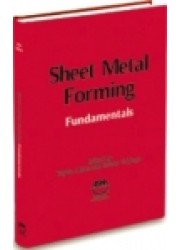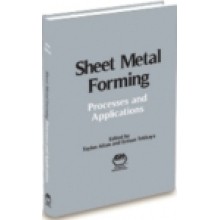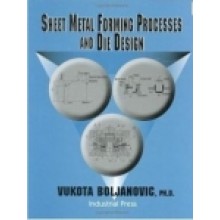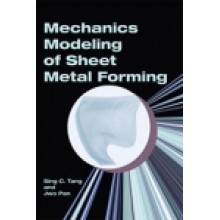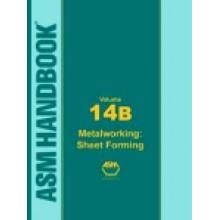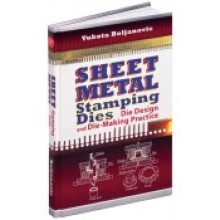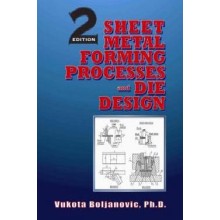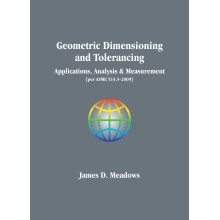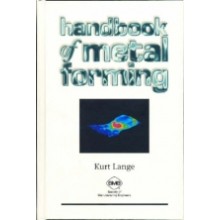Your shopping cart is empty!
Welcome visitor you can login or create an account
Sheet Metal Forming Fundamentals
List Price: $199.00
Our Price: $175.00
Discount : 12%
Our Price: $175.00
Discount : 12%
Quantity:
-
Add to Compare
Sheet forming fundamentals are thoroughly addressed in this comprehensive reference for the practical and efficient use of sheet forming technologies. The principle variables of sheet forming—including the interactions between variables—are clearly explained, as a basic foundation for the most effective use of computer aided modeling in process and die design. Topics include stress analysis, formability criteria, tooling, and materials for sheet forming. The book also covers the latest developments in sheet metal forming technology including servo-drive presses and their applications, and advanced cushion systems in mechanical and hydraulic presses.
Contents
Chapter 1: Metal Forming Processes in Manufacturing
1.1 Classification of Manufacturing Processes
1.2 Characteristics of Manufacturing Processes
1.3 Metal Forming Processes in Manufacturing
1.4 Classification of Metal Forming Processes
Chapter 2: Classification and Description of Sheet Metal Forming Operations
2.1 Process Variables
2.2 Sheet Metal Forming as a System
2.3 Classification of Geometries
2.4 Bending and Flanging
2.5 Blank Preparation
2.6 Deep Drawing
2.7 Stretch Forming
2.8 Incremental Forming
2.9 Hybrid Forming Processes
Chapter 3: Plastic Deformation—Strain and Strain Rate
3.1 Homogeneous or Uniform Deformation
3.2 Volume Constancy during Plastic Deformation
3.3 Infinitesimal True Strains and Strain Rates
3.4 Principal Strains and Strain Paths
3.5 Equivalent Strain Rate and Equivalent Strain
Chapter 4: Plastic Deformation—Flow Stress, Anisotropy, and Formability
4.1 Tensile Test
4.2 Flow Stress Curves
4.3 Methods to Determine Flow Stress of Sheet Materials
4.4 Formability
4.5 Forming Limit Curves (FLCs)
Chapter 5: Plastic Deformation—State of Stress, Yield Criteria Flow Rule, and
1.1 Classification of Manufacturing Processes
1.2 Characteristics of Manufacturing Processes
1.3 Metal Forming Processes in Manufacturing
1.4 Classification of Metal Forming Processes
Chapter 2: Classification and Description of Sheet Metal Forming Operations
2.1 Process Variables
2.2 Sheet Metal Forming as a System
2.3 Classification of Geometries
2.4 Bending and Flanging
2.5 Blank Preparation
2.6 Deep Drawing
2.7 Stretch Forming
2.8 Incremental Forming
2.9 Hybrid Forming Processes
Chapter 3: Plastic Deformation—Strain and Strain Rate
3.1 Homogeneous or Uniform Deformation
3.2 Volume Constancy during Plastic Deformation
3.3 Infinitesimal True Strains and Strain Rates
3.4 Principal Strains and Strain Paths
3.5 Equivalent Strain Rate and Equivalent Strain
Chapter 4: Plastic Deformation—Flow Stress, Anisotropy, and Formability
4.1 Tensile Test
4.2 Flow Stress Curves
4.3 Methods to Determine Flow Stress of Sheet Materials
4.4 Formability
4.5 Forming Limit Curves (FLCs)
Chapter 5: Plastic Deformation—State of Stress, Yield Criteria Flow Rule, and
Hardening Rules
5.1 General State of Stress
5.2 Principal Stresses
5.3 Volumetric Stress or Hydrostatic Pressure
5.4 Deviatoric Stress
5.5 Isotropic Yield Criteria (Flow Criteria)
5.6 Tresca Yield Criterion
5.7 Von Mises Yield Criterion
5.8 Comparison of Tresca and von Mises Criteria
5.9 Anisotropic Yield Criteria
5.10 Flow Rules
5.11 Power and Energy of Deformation
5.12 Effective Strain and Effective Strain Rate
5.13 Hardening Laws
Chapter 6: Materials for Sheet Forming
6.1 Low-Carbon Sheet Steels
6.2 Coated Sheet Steels
6.3 Stainless Steels
6.4 Aluminum Alloys
6.5 Magnesium Alloys
Chapter 7: Friction and Lubrication
7.1 Lubrication Mechanisms and Friction Laws
7.2 Lubricants for Sheet Metal Forming
7.3 Tribological Tests for Evaluation of Lubricants in Sheet Metal Forming
7.4 Tribological Tests for Warm and Hot Stamping
7.5 Tribological Tests for Punching and Blanking
Chapter 8: Deep Drawing of Round and Rectangular Cups
8.1 Deformation during Deep Drawing
8.2 Deep Drawing of Rectangular Cups
8.3 Prediction of Punch Force and BHF—Case Study
Chapter 9: Principles of Sheet Forming Presses
9.1 Components of Presses
9.2 Characteristics of Presses
9.3 Quick Die Change Systems
Chapter 10: Mechanical Presses
10.1 Mechanical Press Designs
10.2 Characteristics of Mechanical Presses
10.3 Other Features of Mechanical Presses
Chapter 11: Electromechanical Servo-Drive Presses
11.1 Servo-Press Drives Versus Conventional Press Drives
11.2 Servo-Press Drives
11.3 Applications
11.4 Cushions/Die Cushions
11.5 Comparison of Mechanical and Servo Presses
11.6 New Process Development Using Servo-Press Characteristics
11.7 Summary
Chapter 12: Hydraulic Presses
12.1 Components of Hydraulic Presses
12.2 Drive Systems
12.3 Characteristics of Hydraulic Presses
12.4 Hydraulic Press Designs
Chapter 13: Cushion Systems for Sheet Metal Forming
13.1 Blank holder Systems in Double-Action Presses
13.2 Single-Action Presses with Cushion System
13.3 Multipoint Cushion (MPC) Systems
Appendix A: Flow Stress Curves
Appendix B: Glossary
Index
5.1 General State of Stress
5.2 Principal Stresses
5.3 Volumetric Stress or Hydrostatic Pressure
5.4 Deviatoric Stress
5.5 Isotropic Yield Criteria (Flow Criteria)
5.6 Tresca Yield Criterion
5.7 Von Mises Yield Criterion
5.8 Comparison of Tresca and von Mises Criteria
5.9 Anisotropic Yield Criteria
5.10 Flow Rules
5.11 Power and Energy of Deformation
5.12 Effective Strain and Effective Strain Rate
5.13 Hardening Laws
Chapter 6: Materials for Sheet Forming
6.1 Low-Carbon Sheet Steels
6.2 Coated Sheet Steels
6.3 Stainless Steels
6.4 Aluminum Alloys
6.5 Magnesium Alloys
Chapter 7: Friction and Lubrication
7.1 Lubrication Mechanisms and Friction Laws
7.2 Lubricants for Sheet Metal Forming
7.3 Tribological Tests for Evaluation of Lubricants in Sheet Metal Forming
7.4 Tribological Tests for Warm and Hot Stamping
7.5 Tribological Tests for Punching and Blanking
Chapter 8: Deep Drawing of Round and Rectangular Cups
8.1 Deformation during Deep Drawing
8.2 Deep Drawing of Rectangular Cups
8.3 Prediction of Punch Force and BHF—Case Study
Chapter 9: Principles of Sheet Forming Presses
9.1 Components of Presses
9.2 Characteristics of Presses
9.3 Quick Die Change Systems
Chapter 10: Mechanical Presses
10.1 Mechanical Press Designs
10.2 Characteristics of Mechanical Presses
10.3 Other Features of Mechanical Presses
Chapter 11: Electromechanical Servo-Drive Presses
11.1 Servo-Press Drives Versus Conventional Press Drives
11.2 Servo-Press Drives
11.3 Applications
11.4 Cushions/Die Cushions
11.5 Comparison of Mechanical and Servo Presses
11.6 New Process Development Using Servo-Press Characteristics
11.7 Summary
Chapter 12: Hydraulic Presses
12.1 Components of Hydraulic Presses
12.2 Drive Systems
12.3 Characteristics of Hydraulic Presses
12.4 Hydraulic Press Designs
Chapter 13: Cushion Systems for Sheet Metal Forming
13.1 Blank holder Systems in Double-Action Presses
13.2 Single-Action Presses with Cushion System
13.3 Multipoint Cushion (MPC) Systems
Appendix A: Flow Stress Curves
Appendix B: Glossary
Index
Write a review
Your Name:Your Review: Note: HTML is not translated!
Rating: Bad Good
Enter the code in the box below:
Price subject to change without notice
Copyright © 2014 Engineering Standards Bureau. All Rights Reserved.
Developed By Zoom Into Web
Copyright © 2014 Engineering Standards Bureau. All Rights Reserved.
Developed By Zoom Into Web


